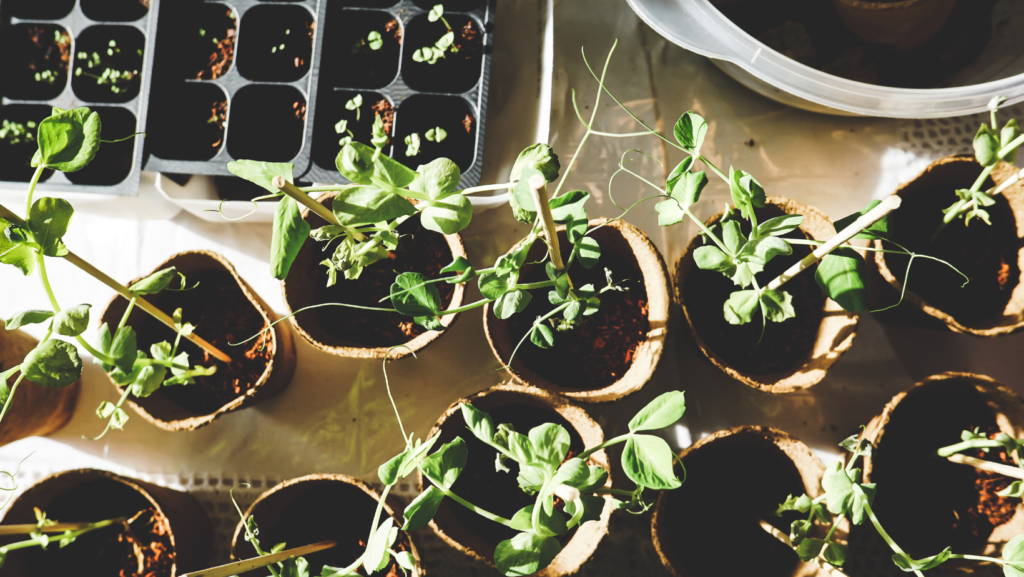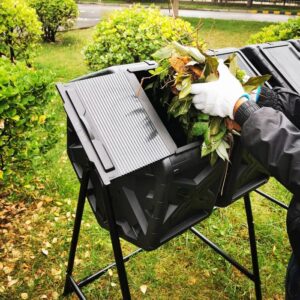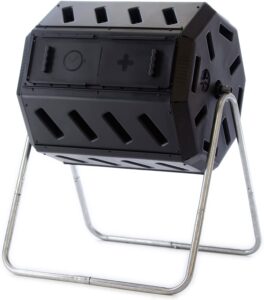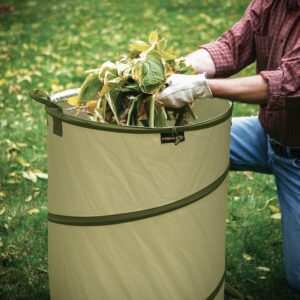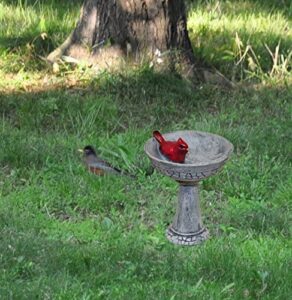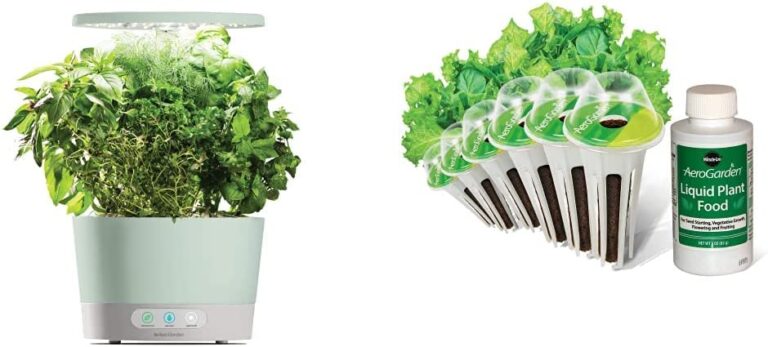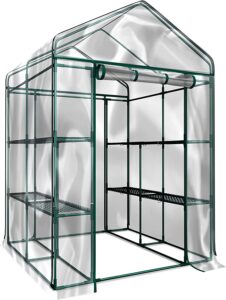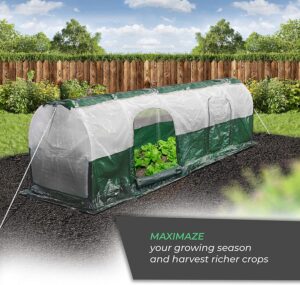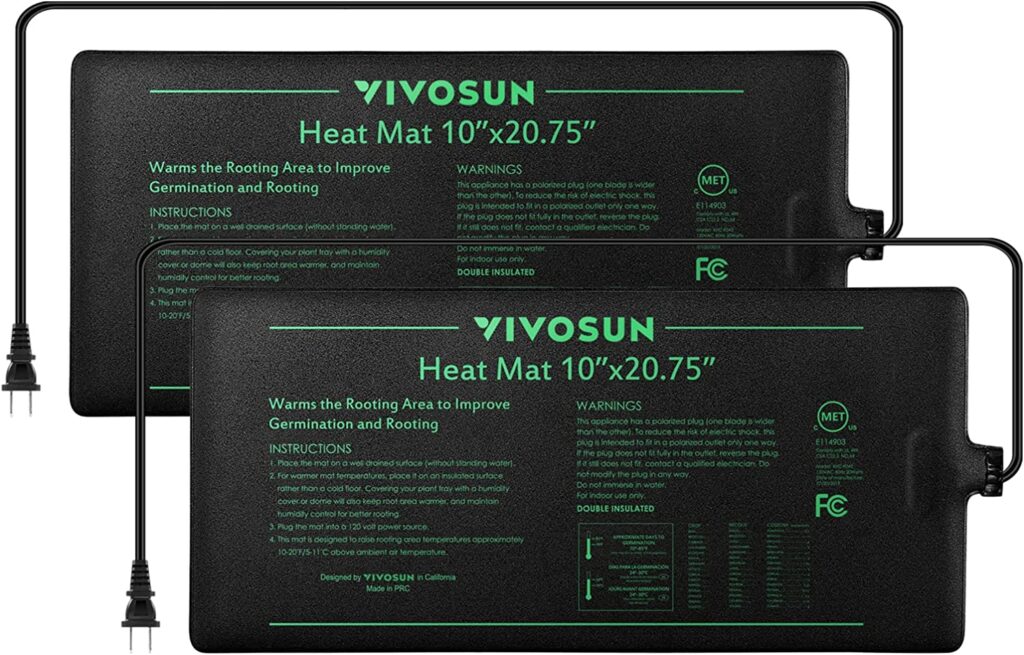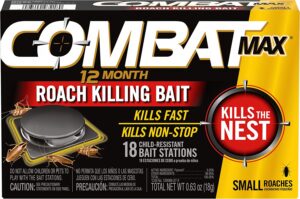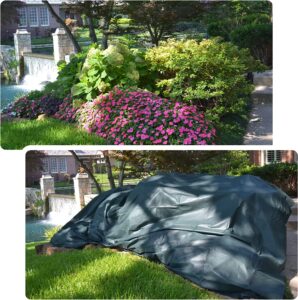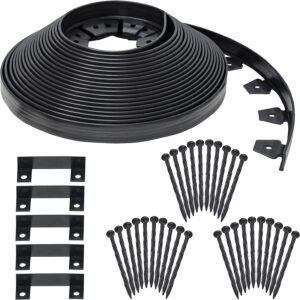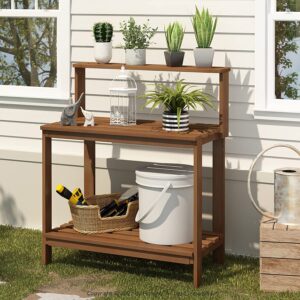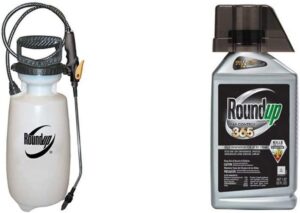Garden and Lawn Care
Garden and lawn care involves the maintenance and upkeep of outdoor spaces such as lawns, gardens, and other landscaped areas. Proper care can help to ensure that these areas remain healthy and vibrant, while also improving their aesthetic appeal.
Some common tasks involved in garden and lawn care include mowing, trimming, weeding, fertilizing, and watering. Depending on the specific needs of your outdoor space, you may also need to prune trees and shrubs, apply pest control treatments, or aerate the soil to improve root health.
To make these tasks easier, there is a wide range of garden and lawn care equipment available, including lawn mowers, trimmers, edgers, sprinklers, and more. By investing in the right tools and following a regular maintenance schedule, you can keep your outdoor space looking its best and enjoy all of the benefits that come with a healthy and beautiful garden or lawn.
1. Outdoor Composting Bin
An outdoor composting bin is a container used to facilitate the process of composting organic waste in an outdoor setting. Composting is the process of breaking down organic material, such as food scraps, yard waste, and other biodegradable materials, into nutrient-rich soil that can be used to fertilize gardens, lawns, and other outdoor spaces.
Outdoor composting bins come in a variety of sizes, styles, and materials, such as plastic, wood, and metal. They typically have a lid to keep pests and rodents out and provide ventilation to encourage airflow and decomposition.
To use an outdoor composting bin, simply add organic material to the bin, such as food scraps, leaves, grass clippings, and garden waste. Over time, the material will decompose and transform into nutrient-rich soil that can be used to improve the health of your outdoor space.
Using an outdoor composting bin is an eco-friendly way to reduce waste and create a sustainable source of natural fertilizer. It’s also an easy way to help the environment and make a positive impact on the world around you. (See More)
2. Outdoor Composting Tumbler
An outdoor composting tumbler is a container that facilitates the process of composting organic waste in an outdoor setting. It is designed to be rotated, or tumbled, to mix the organic material and promote faster decomposition.
Outdoor composting tumblers come in a variety of sizes, styles, and materials, such as plastic, metal, or wood. They typically have a cylindrical shape with a handle or mechanism that allows the container to be easily rotated.
To use an outdoor composting tumbler, simply add organic material to the container, such as food scraps, leaves, grass clippings, and garden waste. Then, rotate the tumbler regularly to mix the materials and promote decomposition. Some outdoor composting tumblers also have features like aeration systems or screens to help speed up the composting process.
Outdoor composting tumblers are a convenient and efficient way to turn organic waste into nutrient-rich soil for your garden or lawn. They are particularly useful for smaller outdoor spaces or for gardeners who want a more controlled and contained composting system. With regular use, an outdoor composting tumbler can help reduce waste and create a sustainable source of natural fertilizer for your outdoor space. (See More)
3. Yard Waste Bag
A yard waste bag is a container used to collect and dispose of organic waste, such as leaves, grass clippings, and other yard debris. Yard waste bags are typically made of durable, biodegradable materials like paper or compostable plastics, and are designed to be used for short-term storage of yard waste before it is collected for composting or disposal.
Yard waste bags come in a variety of sizes and shapes, with some designed for use with lawn mowers or leaf blowers for easy collection. Many municipalities have specific regulations for the use of yard waste bags, such as requirements for the use of compostable bags or limits on the amount of yard waste that can be collected.
Using yard waste bags is an eco-friendly way to manage yard waste and reduce the amount of organic material that ends up in landfills. By collecting and disposing of yard waste in a responsible way, gardeners can help to improve the health of the environment and support sustainable practices in their community. (See More)
4. Garden Miniature
A garden miniature, also known as a fairy garden or miniature garden, is a small-scale garden that is typically designed to evoke a sense of whimsy and fantasy. These gardens often feature miniature plants, structures, and figurines, and are designed to be viewed up close, like a tiny world in a pot or a corner of your garden.
Garden miniatures can be made in a variety of sizes and styles, from a simple pot with a few small plants and figurines, to more elaborate designs that include miniature buildings, pathways, and water features. Many gardeners enjoy creating garden miniatures as a way to express their creativity and add a touch of fun and whimsy to their outdoor space.
Creating a garden miniature can be a fun and rewarding project for gardeners of all skill levels. To make your own miniature garden, start by selecting a container and filling it with a suitable growing medium. Then, add miniature plants and other decorative elements like figurines, small stones, and miniature structures to create the desired effect.
Whether you choose to create a small-scale fairy garden or a more elaborate miniature landscape, a garden miniature can be a fun and creative way to add a touch of magic to your outdoor space. (See More)
5. Gazing Ball
Gazing balls are decorative spheres that are traditionally made of glass or other reflective materials, such as stainless steel or polished stone. They are typically used as garden ornaments or yard art, and can add a touch of color and sparkle to an outdoor space.
Gazing balls are often placed on a stand or pedestal to elevate them off the ground and allow them to be easily viewed from multiple angles. They come in a variety of sizes and colors, and can be used to create a focal point in a garden or to add a pop of color to a flower bed or outdoor space.
In addition to their decorative function, gazing balls are also said to have a mystical quality, with some people believing that they can bring good luck and positive energy to a space. In Feng Shui, gazing balls are thought to bring harmony and balance to a garden, while in other cultures they are said to ward off evil spirits or negative energy.
Whether you believe in their mystical qualities or simply appreciate their beauty, gazing balls can be a charming addition to any garden or outdoor space. (See More)
6. Plant Germination Kit
A plant germination kit is a set of materials designed to help gardeners start their own plants from seeds. These kits typically include trays, containers, soil or growing medium, and sometimes heating pads or lights to create the ideal conditions for germination.
Plant germination kits are a convenient way to start plants indoors, especially if you live in a colder climate or want to get a head start on the growing season. By starting your own plants from seeds, you can also have greater control over the quality and variety of the plants you grow, and can save money compared to buying seedlings from a garden center.
To use a plant germination kit, simply follow the instructions included in the kit. Typically, you will add soil or growing medium to the tray or container provided, plant the seeds, and then cover them with a lid or plastic wrap to create a humid environment that promotes germination. Depending on the kit, you may also need to provide additional heat or light to ensure optimal growing conditions.
Plant germination kits can be a fun and educational project for gardeners of all ages, and can help you to develop a deeper appreciation for the process of growing plants from seeds. By starting your own plants from seeds, you can enjoy the satisfaction of watching them grow from tiny sprouts into full-grown plants, and can have a greater sense of ownership and connection to the plants in your garden. (See More)
7. Plant Germination Tray
A plant germination tray, also known as a seed starting tray, is a container designed to hold soil or other growing medium for starting plants from seeds. These trays typically have small cells or compartments that are perfect for planting individual seeds, and may have a clear plastic or dome-shaped lid to create a humid environment that promotes germination.
Plant germination trays are a convenient way to start seeds indoors, as they help to create a consistent and controlled growing environment. They are often used by gardeners who live in colder climates or who want to get a head start on the growing season, and can be a cost-effective way to grow a large number of plants from seeds.
To use a plant germination tray, simply fill the compartments with soil or growing medium, plant the seeds, and water as needed. Depending on the tray and the type of seeds you are planting, you may also need to provide additional heat or light to ensure optimal growing conditions.
Plant germination trays come in a variety of sizes and materials, and can be reused year after year. They are a great way to get started with indoor seed starting and can help you to develop a deeper appreciation for the process of growing plants from seeds. By starting your own plants from seeds, you can enjoy the satisfaction of watching them grow from tiny sprouts into full-grown plants, and can have a greater sense of ownership and connection to the plants in your garden. (See More)
8. Greenhouses
A greenhouse is a structure, typically made of glass or transparent plastic, that is designed to provide a controlled environment for growing plants. Greenhouses can be used to extend the growing season, to grow plants that are not native to the local climate, or to grow plants that require specific environmental conditions.
Greenhouses work by trapping heat and light from the sun inside the structure, creating a warm and humid environment that is ideal for plant growth. They can also protect plants from extreme weather conditions like frost, wind, and heavy rain, and can help to keep pests and other unwanted critters away.
Greenhouses come in a variety of shapes and sizes, from small, portable models that can be set up in a backyard or on a balcony, to large, commercial-grade structures that are used to grow plants on a large scale. They can be made from a variety of materials, including glass, polycarbonate, and high-quality plastics, and can be designed with features like automated ventilation and temperature controls to create the ideal growing environment.
In addition to their practical function, greenhouses can also be a beautiful addition to a garden or outdoor space. They can be designed to blend in with their surroundings or to make a statement with bold colors or striking architectural features. Whether you are a serious gardener or simply looking for a way to extend the growing season, a greenhouse can be a valuable tool for growing healthy, beautiful plants. (See More)
9. Grow Tent
A grow tent is a small, enclosed structure that is designed to provide an indoor growing environment for plants. Grow tents are typically made from lightweight, waterproof materials, and feature reflective interiors to maximize the amount of light that reaches the plants. They also usually have built-in ventilation systems to help regulate temperature and humidity.
Grow tents are popular with indoor gardeners because they provide a controlled environment that can be customized to the specific needs of the plants being grown. They are especially useful for growing plants that require a lot of light, as the reflective interior helps to maximize the amount of light that reaches the plants.
To use a grow tent, you will typically set it up in a convenient location, such as a spare room or a closet, and then install grow lights, ventilation, and other equipment as needed. You will also need to choose a growing medium, such as soil or hydroponic solutions, and plant your seeds or seedlings.
One of the main benefits of using a grow tent is that it allows you to grow plants indoors, even if you do not have access to outdoor space or if you live in a climate that is not conducive to year-round gardening. They are also a convenient way to grow plants that require specific environmental conditions, such as high humidity or warm temperatures.
Overall, grow tents are a versatile and cost-effective way to grow plants indoors, and can be a valuable tool for anyone interested in indoor gardening or hydroponics. (See More)
10. Plant Heating Mats
Plant heating mats, also known as seedling heat mats or seedling heat mats, are a type of gardening tool that provides a warm and consistent temperature for seed germination and plant growth. These mats are made of a waterproof material and contain heating elements that generate warmth to help seeds germinate and young plants grow.
Plant heating mats are especially useful for gardeners who live in colder climates or who want to start their plants earlier in the season, as they can help to create a warm and stable environment for seeds to germinate and young plants to grow. They can also help to speed up the germination process, which means you can get a head start on your gardening season.
To use a plant heating mat, simply place the mat on a flat surface and plug it in. Then, place your seed trays or pots on the mat, and the warmth generated by the mat will help to encourage seed germination and plant growth. Plant heating mats are usually designed to be used with seed trays or pots, and come in a range of sizes to accommodate different types of containers.
When using a plant heating mat, it is important to monitor the temperature carefully to ensure that it does not get too hot, as this can damage the seeds or young plants. Some plant heating mats come with built-in thermostats or temperature controls to help regulate the heat output, while others require manual monitoring and adjustment.
Overall, plant heating mats are a valuable tool for any gardener who wants to start their plants early, speed up the germination process, or create a warm and stable environment for their seeds and plants to grow. (See More)
11.Pest Control Product
Pest control products are designed to help eliminate or prevent the presence of pests in homes, gardens, and other outdoor areas. Pests can include insects, rodents, birds, and other animals that can cause damage to property or pose a health risk to humans or pets.
There are a variety of pest control products available, including chemical and non-chemical options. Chemical pest control products include insecticides, rodenticides, and other treatments that are designed to kill or repel pests. Non-chemical pest control products, on the other hand, use physical barriers or other natural methods to prevent pests from entering or infesting an area.
Examples of chemical pest control products include sprays, baits, and foggers that are designed to kill or repel insects like mosquitoes, ants, and roaches. Rodenticides, such as bait stations and traps, are designed to eliminate rodents like mice and rats.
Non-chemical pest control products include physical barriers like netting and mesh to keep birds and other animals away from crops or gardens. Other methods include using natural predators like ladybugs or nematodes to control pests like aphids and grubs.
It’s important to use pest control products carefully and according to the instructions provided to avoid any potential health risks or environmental damage. Some products may be harmful to children, pets, or beneficial insects like bees, so it’s important to choose the right product for the type of pest you are dealing with, and to use it safely and responsibly. (See More)
12. Plant Cover
Plant covers, also known as frost blankets or plant protectors, are designed to help protect plants from cold temperatures, wind, and frost damage. These covers can be made from a variety of materials, including fabric, plastic, and netting, and are typically lightweight and easy to use.
Plant covers work by trapping heat and moisture around the plants, which helps to create a warmer and more stable environment. This can be especially important in areas with unpredictable weather patterns, or for plants that are sensitive to cold temperatures.
Plant covers are available in a range of sizes and styles to accommodate different types of plants, from small seedlings to larger shrubs and trees. Some covers are designed to be draped over individual plants, while others can be used to cover entire garden beds.
When using a plant cover, it is important to make sure that the cover is securely in place and that there are no gaps or holes that could let in cold air or pests. It’s also important to remove the cover periodically to check on the plants and to make sure that they are not getting too wet or too dry.
Plant covers can be a valuable tool for any gardener who wants to protect their plants from cold weather or frost damage. They are an affordable and effective way to extend the growing season and ensure that your plants stay healthy and productive. (See More)
13. Plant Support Structure
Plant support structures, also known as trellises or stakes, are designed to help keep plants upright and prevent them from falling over or breaking under the weight of their fruit or foliage. These structures are typically made of materials like wood, metal, or plastic, and are available in a range of sizes and styles to accommodate different types of plants and growing conditions.
There are several different types of plant support structures, including:
Stakes: These are vertical supports that are driven into the ground near the base of the plant. They can be made of wood, metal, or plastic, and are used to provide support for single-stemmed plants like tomatoes, peppers, and beans.
Trellises: These are typically made of a grid-like structure that can be placed against a wall or fence or used as a standalone structure. They are often used for vining plants like cucumbers, squash, and melons.
Cages: These are made of a wire or plastic mesh and are typically used to support and contain bushy plants like tomatoes and peppers.
A-frames: These are a type of trellis that is designed to support plants growing in rows. They are made of a series of vertical stakes connected by a horizontal beam, forming an A-shape.
Plant support structures can help improve the health and yield of plants by keeping them upright and allowing for better airflow and exposure to sunlight. They can also help to prevent damage from wind, heavy rains, and other weather conditions that can cause plants to fall over or break. Using plant support structures can also make it easier to harvest fruits and vegetables, as they can be trained to grow in a more organized and accessible manner. (See More)
14. Gardening Pot
Gardening pots, also known as planters, are containers that are used to grow plants in a variety of settings, including indoor and outdoor gardens, patios, balconies, and other small spaces. Pots are available in a wide range of materials, including clay, ceramic, plastic, metal, and even fabric.
There are several advantages to using gardening pots. They allow for more flexibility in terms of plant placement and can be easily moved around to take advantage of sunlight or to protect plants from harsh weather conditions. Pots can also be used to create a variety of decorative arrangements, and are available in a range of sizes, colors, and styles to suit different tastes and settings.
When choosing a gardening pot, it’s important to consider the needs of the plant you will be growing. Different plants have different requirements when it comes to soil type, moisture levels, and drainage, and it’s important to choose a pot that is appropriately sized and designed to accommodate these needs. For example, plants that require good drainage may need a pot with a drainage hole, while plants that prefer moist soil may benefit from a self-watering pot.
In addition to traditional gardening pots, there are also specialized types of pots available, such as hanging baskets, wall planters, and window boxes, that are designed to fit specific growing environments. These types of pots can be especially useful in small or urban spaces where floor space may be limited.
Overall, gardening pots are a versatile and convenient tool for any gardener, and can be used to create a variety of beautiful and productive growing spaces. (See More)
15. Potting Benche & Table
A potting bench or table is a piece of outdoor furniture that is designed to provide a workspace for gardening tasks, such as transplanting seedlings, potting plants, and organizing gardening tools. Potting benches come in a variety of styles and sizes, from simple tables to more elaborate structures with built-in storage and shelving.
A potting bench typically features a flat work surface that is wide enough to accommodate gardening tasks, as well as a variety of other features designed to make gardening more convenient and efficient. Some potting benches include built-in sinks or water systems for easy access to water, while others may have built-in storage shelves or drawers for holding gardening tools and supplies.
Potting benches are often made from durable materials such as wood, metal, or plastic. They can be placed in a garden, on a patio or balcony, or in a greenhouse, and are especially useful for gardeners who enjoy working outside.
One of the main benefits of using a potting bench is that it provides a dedicated workspace for gardening tasks, making it easier to stay organized and efficient. By having all of the necessary tools and supplies at hand, gardeners can focus on their work and complete tasks more quickly and with less effort. Potting benches can also help reduce strain on the back and knees by providing a comfortable working height.
Overall, a potting bench or table can be a valuable addition to any gardener’s toolkit, providing a convenient and functional space for a variety of gardening tasks. (See More)
16. Weed Killer
Weed killers, also known as herbicides, are chemical or natural products that are designed to control or eliminate unwanted weeds in a garden or outdoor space. There are several types of weed killers available, including systemic, contact, and pre-emergent herbicides.
Systemic weed killers are absorbed by the plant and then spread throughout its tissues, eventually killing the entire plant. Contact weed killers, on the other hand, work by coming into direct contact with the leaves and stems of the plant, killing it on contact. Pre-emergent weed killers are designed to prevent weed seeds from germinating, and are typically applied to the soil before planting.
While weed killers can be effective at controlling weeds, it’s important to use them carefully and according to the instructions provided. Some weed killers can be harmful to beneficial plants or animals, so it’s important to choose a product that is appropriate for the specific weeds you are trying to control and the plants you are trying to protect.
In addition to chemical weed killers, there are also natural and organic weed control methods available. These may include mulching, hand weeding, or using natural products such as vinegar or boiling water to kill weeds.
Overall, weed killers can be a useful tool for gardeners looking to control weeds and maintain a healthy garden. By choosing the right product and using it carefully, gardeners can enjoy a weed-free garden without harming the environment or beneficial plants and animals. (See More)
Garden and Lawn Care Conclusion
Maintaining a healthy and beautiful garden and lawn requires the use of a variety of tools and equipment. From composting bins and outdoor tumblers to plant support structures and weed killers, there are many products available to help gardeners achieve their desired results.
It’s important to choose products that are appropriate for the specific needs of your garden and lawn, and to use them carefully and according to the instructions provided. By taking care to choose the right equipment and products, gardeners can create a thriving outdoor space that is both beautiful and sustainable.
Whether you’re a seasoned gardener or just starting out, there are many resources available to help you achieve your gardening goals. With the right tools, equipment, and knowledge, anyone can create a stunning garden and lawn that brings joy and beauty to their outdoor space.

